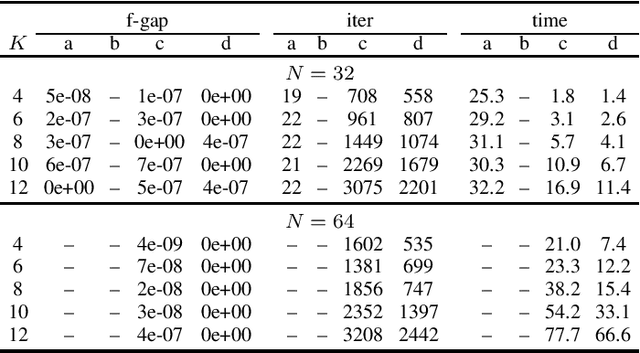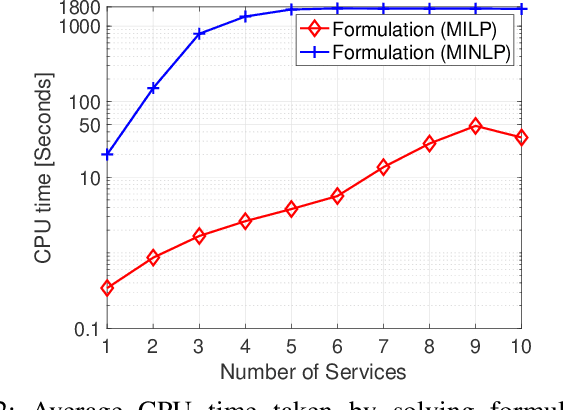Ya-Feng Liu
A Unified Distributed Algorithm for Hybrid Near-Far Field Activity Detection in Cell-Free Massive MIMO
Sep 18, 2025Abstract:A great amount of endeavor has recently been devoted to activity detection for massive machine-type communications in cell-free multiple-input multiple-output (MIMO) systems. However, as the number of antennas at the access points (APs) increases, the Rayleigh distance that separates the near-field and far-field regions also expands, rendering the conventional assumption of far-field propagation alone impractical. To address this challenge, this paper establishes a covariance-based formulation that can effectively capture the statistical property of hybrid near-far field channels. Based on this formulation, we theoretically reveal that increasing the proportion of near-field channels enhances the detection performance. Furthermore, we propose a distributed algorithm, where each AP performs local activity detection and only exchanges the detection results to the central processing unit, thus significantly reducing the computational complexity and the communication overhead. Not only with convergence guarantee, the proposed algorithm is unified in the sense that it can handle single-cell or cell-free systems with either near-field or far-field devices as special cases. Simulation results validate the theoretical analyses and demonstrate the superior performance of the proposed approach compared with existing methods.
Asymptotic Analysis of Nonlinear One-Bit Precoding in Massive MIMO Systems via Approximate Message Passing
Sep 17, 2025Abstract:Massive multiple-input multiple-output (MIMO) systems employing one-bit digital-to-analog converters offer a hardware-efficient solution for wireless communications. However, the one-bit constraint poses significant challenges for precoding design, as it transforms the problem into a discrete and nonconvex optimization task. In this paper, we investigate a widely adopted ``convex-relaxation-then-quantization" approach for nonlinear symbol-level one-bit precoding. Specifically, we first solve a convex relaxation of the discrete minimum mean square error precoding problem, and then quantize the solution to satisfy the one-bit constraint. To analyze the high-dimensional asymptotic performance of this scheme, we develop a novel analytical framework based on approximate message passing (AMP). This framework enables us to derive a closed-form expression for the symbol error probability (SEP) at the receiver side in the large-system limit, which provides a quantitative characterization of how model and system parameters affect the SEP performance. Our empirical results suggest that the $\ell_\infty^2$ regularizer, when paired with an optimally chosen regularization parameter, achieves optimal SEP performance within a broad class of convex regularization functions. As a first step towards a theoretical justification, we prove the optimality of the $\ell_\infty^2$ regularizer within the mixed $\ell_\infty^2$-$\ell_2^2$ regularization functions.
Distributed Activity Detection for Cell-Free Hybrid Near-Far Field Communications
Jun 17, 2025Abstract:A great amount of endeavor has recently been devoted to activity detection for massive machine-type communications in cell-free massive MIMO. However, in practice, as the number of antennas at the access points (APs) increases, the Rayleigh distance that separates the near-field and far-field regions also expands, rendering the conventional assumption of far-field propagation alone impractical. To address this challenge, this paper considers a hybrid near-far field activity detection in cell-free massive MIMO, and establishes a covariance-based formulation, which facilitates the development of a distributed algorithm to alleviate the computational burden at the central processing unit (CPU). Specifically, each AP performs local activity detection for the devices and then transmits the detection result to the CPU for further processing. In particular, a novel coordinate descent algorithm based on the Sherman-Morrison-Woodbury update with Taylor expansion is proposed to handle the local detection problem at each AP. Moreover, we theoretically analyze how the hybrid near-far field channels affect the detection performance. Simulation results validate the theoretical analysis and demonstrate the superior performance of the proposed approach compared with existing approaches.
An Adaptive Proximal Inexact Gradient Framework and Its Application to Per-Antenna Constrained Joint Beamforming and Compression Design
Apr 02, 2025Abstract:In this paper, we propose an adaptive proximal inexact gradient (APIG) framework for solving a class of nonsmooth composite optimization problems involving function and gradient errors. Unlike existing inexact proximal gradient methods, the proposed framework introduces a new line search condition that jointly adapts to function and gradient errors, enabling adaptive stepsize selection while maintaining theoretical guarantees. Specifically, we prove that the proposed framework achieves an $\epsilon$-stationary point within $\mathcal{O}(\epsilon^{-2})$ iterations for nonconvex objectives and an $\epsilon$-optimal solution within $\mathcal{O}(\epsilon^{-1})$ iterations for convex cases, matching the best-known complexity in this context. We then custom-apply the APIG framework to an important signal processing problem: the joint beamforming and compression problem (JBCP) with per-antenna power constraints (PAPCs) in cooperative cellular networks. This customized application requires careful exploitation of the problem's special structure such as the tightness of the semidefinite relaxation (SDR) and the differentiability of the dual. Numerical experiments demonstrate the superior performance of our custom-application over state-of-the-art benchmarks for the JBCP.
Joint Design of Radar Receive Filter and Unimodular ISAC Waveform with Sidelobe Level Control
Mar 19, 2025Abstract:Integrated sensing and communication (ISAC) has been considered a key feature of next-generation wireless networks. This paper investigates the joint design of the radar receive filter and dual-functional transmit waveform for the multiple-input multiple-output (MIMO) ISAC system. While optimizing the mean square error (MSE) of the radar receive spatial response and maximizing the achievable rate at the communication receiver, besides the constraints of full-power radar receiving filter and unimodular transmit sequence, we control the maximum range sidelobe level, which is often overlooked in existing ISAC waveform design literature, for better radar imaging performance. To solve the formulated optimization problem with convex and nonconvex constraints, we propose an inexact augmented Lagrangian method (ALM) algorithm. For each subproblem in the proposed inexact ALM algorithm, we custom-design a block successive upper-bound minimization (BSUM) scheme with closed-form solutions for all blocks of variable to enhance the computational efficiency. Convergence analysis shows that the proposed algorithm is guaranteed to provide a stationary and feasible solution. Extensive simulations are performed to investigate the impact of different system parameters on communication and radar imaging performance. Comparison with the existing works shows the superiority of the proposed algorithm.
Covariance-Based Device Activity Detection with Massive MIMO for Near-Field Correlated Channels
Nov 08, 2024



Abstract:This paper studies the device activity detection problem in a massive multiple-input multiple-output (MIMO) system for near-field communications (NFC). In this system, active devices transmit their signature sequences to the base station (BS), which detects the active devices based on the received signal. In this paper, we model the near-field channels as correlated Rician fading channels and formulate the device activity detection problem as a maximum likelihood estimation (MLE) problem. Compared to the traditional uncorrelated channel model, the correlation of channels complicates both algorithm design and theoretical analysis of the MLE problem. On the algorithmic side, we propose two computationally efficient algorithms for solving the MLE problem: an exact coordinate descent (CD) algorithm and an inexact CD algorithm. The exact CD algorithm solves the one-dimensional optimization subproblem exactly using matrix eigenvalue decomposition and polynomial root-finding. By approximating the objective function appropriately, the inexact CD algorithm solves the one-dimensional optimization subproblem inexactly with lower complexity and more robust numerical performance. Additionally, we analyze the detection performance of the MLE problem under correlated channels by comparing it with the case of uncorrelated channels. The analysis shows that when the overall number of devices $N$ is large or the signature sequence length $L$ is small, the detection performance of MLE under correlated channels tends to be better than that under uncorrelated channels. Conversely, when $N$ is small or $L$ is large, MLE performs better under uncorrelated channels than under correlated ones. Simulation results demonstrate the computational efficiency of the proposed algorithms and verify the correctness of the analysis.
A New Adaptive Balanced Augmented Lagrangian Method with Application to ISAC Beamforming Design
Oct 20, 2024
Abstract:In this paper, we consider a class of convex programming problems with linear equality constraints, which finds broad applications in machine learning and signal processing. We propose a new adaptive balanced augmented Lagrangian (ABAL) method for solving these problems. The proposed ABAL method adaptively selects the stepsize parameter and enjoys a low per-iteration complexity, involving only the computation of a proximal mapping of the objective function and the solution of a linear equation. These features make the proposed method well-suited to large-scale problems. We then custom-apply the ABAL method to solve the ISAC beamforming design problem, which is formulated as a nonlinear semidefinite program in a previous work. This customized application requires careful exploitation of the problem's special structure such as the property that all of its signal-to-interference-and-noise-ratio (SINR) constraints hold with equality at the solution and an efficient computation of the proximal mapping of the objective function. Simulation results demonstrate the efficiency of the proposed ABAL method.
QoS-Aware and Routing-Flexible Network Slicing for Service-Oriented Networks
Sep 20, 2024



Abstract:In this paper, we consider the network slicing (NS) problem which attempts to map multiple customized virtual network requests (also called services) to a common shared network infrastructure and manage network resources to meet diverse quality of service (QoS) requirements. We propose a mixed-integer nonlinear programming (MINLP) formulation for the considered NS problem that can flexibly route the traffic flow of the services on multiple paths and provide end-to-end delay and reliability guarantees for all services. To overcome the computational difficulty due to the intrinsic nonlinearity in the MINLP formulation, we transform the MINLP formulation into an equivalent mixed-integer linear programming (MILP) formulation and further show that their continuous relaxations are equivalent. In sharp contrast to the continuous relaxation of the MINLP formulation which is a nonconvex nonlinear programming problem, the continuous relaxation of the MILP formulation is a polynomial-time solvable linear programming problem, which significantly facilitates the algorithmic design. Based on the newly proposed MILP formulation, we develop a customized column generation (cCG) algorithm for solving the NS problem. The proposed cCG algorithm is a decomposition-based algorithm and is particularly suitable for solving large-scale NS problems. Numerical results demonstrate the efficacy of the proposed formulations and the proposed cCG algorithm.
Symbol-Level Precoding-Based Self-Interference Cancellation for ISAC Systems
Sep 13, 2024


Abstract:Consider an integrated sensing and communication (ISAC) system where a base station (BS) employs a full-duplex radio to simultaneously serve multiple users and detect a target. The detection performance of the BS may be compromised by self-interference (SI) leakage. This paper investigates the feasibility of SI cancellation (SIC) through the application of symbol-level precoding (SLP). We first derive the target detection probability in the presence of the SI. We then formulate an SLP-based SIC problem, which optimizes the target detection probability while satisfying the quality of service requirements of all users. The formulated problem is a nonconvex fractional programming (FP) problem with a large number of equality and inequality constraints. We propose a penalty-based block coordinate descent (BCD) algorithm for solving the formulated problem, which allows for efficient closed-form updates of each block of variables at each iteration. Finally, numerical simulation results are presented to showcase the enhanced detection performance of the proposed SIC approach.
An Efficient Convex-Hull Relaxation Based Algorithm for Multi-User Discrete Passive Beamforming
Jul 30, 2024Abstract:Intelligent reflecting surface (IRS) is an emerging technology to enhance spatial multiplexing in wireless networks. This letter considers the discrete passive beamforming design for IRS in order to maximize the minimum signal-to-interference-plus-noise ratio (SINR) among multiple users in an IRS-assisted downlink network. The main design difficulty lies in the discrete phase-shift constraint. Differing from most existing works, this letter advocates a convex-hull relaxation of the discrete constraints which leads to a continuous reformulated problem equivalent to the original discrete problem. This letter further proposes an efficient alternating projection/proximal gradient descent and ascent algorithm for solving the reformulated problem. Simulation results show that the proposed algorithm outperforms the state-of-the-art methods significantly.
* 5 pages
 Add to Chrome
Add to Chrome Add to Firefox
Add to Firefox Add to Edge
Add to Edge